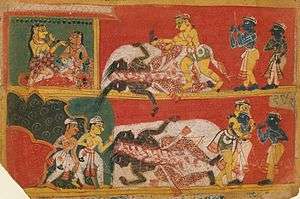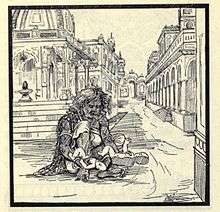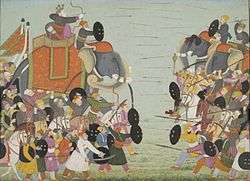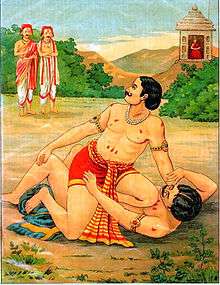Jarasandha
| Jarasandha | |
|---|---|
 Painting showing Bhima slaying Jarasandha | |
| Brihadratha King | |
| Predecessor | Brihadratha |
| Successor | Sahadeva |
| Issue |
Sahadeva Asti Prapti (wives of Kamsa) |
| Dynasty | Brihadratha |
| Father | Brihadratha |
According to the Hindu epic Mahabharata, Jarasandha (Sanskrit: जरासन्ध) was the king of Magadha. He was a descendant of King Brihadratha, the founder of the Barhadratha dynasty of Magadha.He was a great senapati but he is generally held in a negative light owing to his enmity with the Yadava clan in the Mahabharata.
Etymology
The word Jarasandha is a combination of two Sanskrit words, Jara (जरा) and sandha (सन्ध), "joining". Jara was a demoness who put the two halves of Jarasandha together after finding them by a tree. In return for saving Brihadratha's son, he was named Jarasandha after her. The meaning of Jarasandha is 'the one who is joined by Jara'.[1]
Legend about his birth


Jarasandha's father king Brihadratha was married to the twin daughters of the King of Kashi. Brihadratha loved both his wives equally, but had no sons. Once sage Chandakaushika visited his kingdom and gave a mango to the king as a boon. The king divided the mango equally and gave to his both the wives. Soon, both wives became pregnant and gave birth to two halves of a human body. These two lifeless halves were very horrifying to view. So, Brihadratha ordered these to be thrown in the forest. A Rakshasi (demoness) named Jara (or Barmata) found the two pieces and held each of them in her two palms. Incidentally, when she brought both of her palms together, the two pieces joined giving rise to a living child. The child cried loudly which created panic for Jara. Not having the heart to eat a living child, the demoness gave it to the king and explained to him all that had happened. The father was overjoyed to see him.[2]
Chandakaushika arrived at the court and saved the child. He prophesied to Brihadratha that his son would be specially gifted and would be a great devotee of the god Shiva.[3]

People who defeated Jarasandha
- Karna: When Karna goes to Anga first time he saw that people of anga are frightened of jarasandha, then he attack on jarasandha and defeat him.
- Bhima: Bhima killed jarasandha.

Death
When Yudhishthira was trying to conduct Rajasuya ritual, Krishna told him that Jarasandha should be killed to conduct the ritual. Thus Krishna took Bhima and Arjuna to Magadha, disguising themselves as Brahmins. Jarasandha, though finding them suspicious, welcomed the three. Later, when they revealed themselves, they challenged Jarasandha to have a wrestling. Jarasandha took Bhima as his opponent. The fight continued for a long time, and no one became the victor. Finally, Krishna gave a signal to Bhima, by tearing a leaf and dropping it to opposite sides. Bhima took it as a signal and tore Jarasandha's body into two pieces,and throwing left part to right side and right part to the left side,thus killing him.
Notes
- ↑ "Jarasandha was a very powerful king of Magadha, and the history of his birth and activities is also very interesting - Vaniquotes". vaniquotes.org. Retrieved 2015-12-31.
- ↑ Chandrakant, Kamala (1977). Krishna and Jarasandha. India Book House Ltd. pp. 3–5. ISBN 81-7508-080-9.
- ↑ "Slaying of Jarasandha - Indian Mythology". www.apamnapat.com. Retrieved 2016-01-10.
References
- Doniger, Wendy (1993), Purana Perennis: Reciprocity and Transformation in Hindu and Jaina Texts, SUNY Press, ISBN 0-7914-1381-0
- Gibbs,Laura. Ph.D. Jarasandha Modern Languages MLLL-4993. Indian Epics.
- Dowson, John (1820–1881). A classical dictionary of Hindu mythology and religion, geography, history, and literature. London: Trübner, 1879 [Reprint, London: Routledge, 1979]. ISBN 0-415-24521-4
- Original Mahabharata by Shri Ved Vyasa
- Gita press,Gorakhpur edition of Mahābhārata
- Ramanand Sagar's "SHRI KRISHNA" serial
- MRITYUNJAY-the story of Karna.

